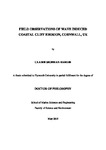Field observations of wave induced coastal cliff erosion, Cornwall, UK
| dc.contributor.supervisor | Masselink, Gerd | |
| dc.contributor.author | Earlie, Claire Siobhan | |
| dc.contributor.other | School of Biological and Marine Sciences | en_US |
| dc.date.accessioned | 2015-08-19T15:10:56Z | |
| dc.date.available | 2015-08-19T15:10:56Z | |
| dc.date.issued | 2015 | |
| dc.date.issued | 2015 | |
| dc.identifier | 775648 | en_US |
| dc.identifier.uri | http://hdl.handle.net/10026.1/3526 | |
| dc.description.abstract |
Coastal cliff erosion is a widespread problem that threatens property and infrastructure along many of the world’s coastlines. The management of this risk calls for robust quantification of cliff erosion rates, which are often difficult to obtain along rocky coasts. Quantification of sea-cliff rates of retreat on annual to decadal time scales has typically been limited to rapidly eroding soft rock coastlines. Rates of erosion used for shoreline management in the UK are generally based on analysis of historic maps and aerial photographs which, in rocky coast environments, does not wholly capture the detail and timing at which the processes operate and the failures occur across the cliff face. The first stage of this study uses airborne LiDAR (Light Detection and Ranging) data at nine sites around a rocky coastline (Cornwall, UK) to gain a quantitative understanding of cliff erosion where average recession rates are relatively low (c. 0.1 m yr-1). It was found that three-dimensional volumetric changes on the cliff face and linear rates of retreat can be reliably calculated from consecutive digital elevation models (DEMs) several years apart. Rates of erosion ranged between 0.03–0.3 m yr-1. The spatial variability in recession rates was considered in terms of the relationship with the varying boundary conditions (rock mass characteristics, cliff geometries, beach morphology) and forcing parameters (wave climate and wave exposure). Recession rates were statistically correlated with significant wave height (Hs), rock mass characteristics (GSI) and the ratio between the two (GSI/Hs). Although the rates derived using airborne LiDAR are comparable to the longer term rates of retreat, the detail of erosion to the cliff-face provides additional insight into the processes occurring in slowly eroding environments, which are vital for understanding the failure of harder rock coastlines. In addition to this, the importance of the wave climate and rainfall needs further attention on a more localised scale. Monthly cliff face volume changes, at two particularly vulnerable sites (Porthleven and Godrevy, Cornwall, UK), were detected using a Terrestrial Laser Scanner (TLS). Using these volumes alongside information on beach profile, beach- cliff junction elevation changes and nearshore hydrodynamics have allowed an insight into how the cliffs respond to seasonal fluctuations in wave climate and beach morphology. Monthly variability in beach morphology between the two sites over a one-year survey period i  indicated the influence that beach slope and the elevation of the beach-cliff junction have on the frequency of inundation and the power of wave-cliff impacts. Failure mechanisms between the two sites ranged from rotational sliding of superficial material to quarrying and block removal over the entire cliff elevation, according to the extent of wave-cliff interaction. This particular survey period highlighted the sensitivity of cliff erosion to the variability in wave climate and beach morphology at two different locations in the south-west of the UK, where the vast majority (over 85% of the annual value) of cliff face erosion occurs during the winter when extreme storm waves prevail. Coastal cliff erosion from storm waves is observed worldwide but the processes are notoriously difficult to measure during extreme storm wave conditions when most erosion normally occurs, limiting our understanding of cliff processes. Over January-March 2014, during the largest Atlantic storms in at least 60 years with deep water significant wave heights of 6 – 8 m, cliff-top ground motions of a rocky cliff in the south-west of the UK (Porthleven, Cornwall) showed vertical ground displacements in excess of 50–100 μm; an order of magnitude larger than observations made previously. Repeat terrestrial laser scanner surveys, over a 2-week period encompassing the extreme storms, gave a cliff face volume loss 2 orders of magnitude larger than the long-term erosion rate. Cliff-top ground motions and erosion volumes were compared at two different locations, one a reflective beach with steeply shelving bathymetry (Porthleven, Cornwall) and the other an intermediate, low tide bar-rip beach with a wide coastal slope (Godrevy, Cornwall). Under similar wave conditions (6–8 m Hs and 15–20 s. Tp) the vertical ground motions were an order of magnitude greater at the cliffs fronted by steeply shelving bathymetry, where the breaking waves plunge right at the shoreline, with little prior dissipation, leading to large energetic runup impacting the cliff. These storm results imply that erosion of coastal cliffs exposed to extreme storm waves is highly episodic and that long-term rates of cliff erosion will depend on the frequency and severity of extreme storm wave impacts as well as the wave dissipation that occurs as a function of the nearshore bathymetry. Having recorded microseismic cliff-top motion on this scale for the first time and determined an effective method of monitoring the energetic wave impacts, this study emphasises how investigations of cliff behaviour during storms is not only obtainable, but paramount to understanding coastal evolution under extreme conditions. | en_US |
| dc.language.iso | en | en_US |
| dc.publisher | Plymouth University | en_US |
| dc.subject | LiDAR | |
| dc.subject | Terrestrial Laser Scanner | |
| dc.subject | Cliff top ground motion | |
| dc.subject | Beach Morphology | |
| dc.subject | Nearshore Hydrodynamics | |
| dc.subject | Hydrodynamics | |
| dc.subject | Extreme Storm Waves | |
| dc.subject | Cliff Erosion | en_US |
| dc.title | Field observations of wave induced coastal cliff erosion, Cornwall, UK | en_US |
| dc.type | Thesis | |
| plymouth.version | Full version | en_US |
| dc.identifier.doi | http://dx.doi.org/10.24382/3339 |
Files in this item
This item appears in the following Collection(s)
-
01 Research Theses Main Collection
Research Theses Main


